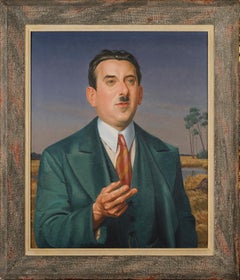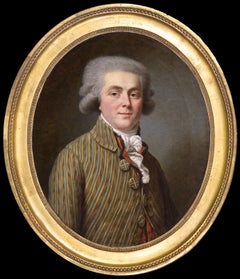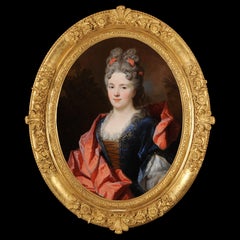Want more images or videos?
Request additional images or videos from the seller
1 of 11
UnknownStudy of a man in armorCirca 1610
Circa 1610
$14,958.78List Price
About the Item
- Creation Year:Circa 1610
- Dimensions:Height: 30.71 in (78 cm)Width: 17.72 in (45 cm)
- Medium:
- Movement & Style:
- Period:1610-1619
- Condition:
- Gallery Location:BELEYMAS, FR
- Reference Number:1stDibs: LU1857215635232
About the Seller
3.0
Vetted Professional Seller
Every seller passes strict standards for authenticity and reliability
Established in 2017
1stDibs seller since 2022
5 sales on 1stDibs
Authenticity Guarantee
In the unlikely event there’s an issue with an item’s authenticity, contact us within 1 year for a full refund. DetailsMoney-Back Guarantee
If your item is not as described, is damaged in transit, or does not arrive, contact us within 7 days for a full refund. Details24-Hour Cancellation
You have a 24-hour grace period in which to reconsider your purchase, with no questions asked.Vetted Professional Sellers
Our world-class sellers must adhere to strict standards for service and quality, maintaining the integrity of our listings.Price-Match Guarantee
If you find that a seller listed the same item for a lower price elsewhere, we’ll match it.Trusted Global Delivery
Our best-in-class carrier network provides specialized shipping options worldwide, including custom delivery.You May Also Like
1850's Large Mid 19th Century French Portrait of a Young Gentleman Signed Oil
Located in Cirencester, Gloucestershire
The French Gentleman
by Paul Goubil (French mid 19th century)
signed and dated 1855
oil on canvas, framed
framed: 30.5 x 25 inches
canvas: 29 x 24 inches
Provenance: private collecti...
Category
Mid-19th Century French School Figurative Paintings
Materials
Oil, Canvas
Mid 19th Century French Provincial Oil Portrait of Lady & Her Dog, framed
Located in Cirencester, Gloucestershire
Portrait of a Lady with her Pet Dog
French School, mid 19th century
oil on canvas, framed
framed: 36 x 28 inches
canvas: 29 x 20 inches
Provenance: private collection, France
Conditi...
Category
Mid-19th Century French School Portrait Paintings
Materials
Oil, Canvas
19th Century French Signed Oil Painting Portrait of Distinguished Gentleman
Located in Cirencester, Gloucestershire
Portrait of Gentleman
French School, late 19th century
indistinctly signed and dated
oil on canvas, unframed
canvas: 28 x 22 inches
Provenance: private collection, France
Condition: ...
Category
Late 19th Century French School Portrait Paintings
Materials
Oil, Canvas
Academic Study
Located in London, GB
Oil on canvas
Signed, dated and dedicated (upper right)
46cm × 38cm (59cm × 51cm framed)
Forichon was a pupil of the Ecole des Beaux-Arts de Paris and was taught by Jean-Léon Gérôme...
Category
1880s French School Figurative Paintings
Materials
Canvas, Oil
Large French Oil painting On Canvas, portrait of a musketeer 19th century
Located in Gavere, BE
Beautiful Oil On Canvas, portrait of a musketeer French school 19th century
This is a French 19th century school with large dimensions .
Very decorative and exclusive portrait paint...
Category
1890s French School Portrait Paintings
Materials
Gold Leaf
$11,383
H 35.44 in W 24.81 in D 0.79 in
Oil Painting On Canvas " young Oriental With Spindle" By Charles Landelle
By Charles Zacharie Landelle
Located in Gavere, BE
"Oil On Canvas "young Oriental With Spindle" By Charles Landelle"
Charles Zacharie Landelle (1821 in Laval - 1908 in Chennevières-sur-Marne)
is a French genre and portrait painter.
...
Category
1870s French School Figurative Paintings
Materials
Canvas, Oil
$22,767
H 58.27 in W 44.89 in D 2.76 in
Oil On Canvas, portrait of a musketeer French school 20th century
Located in Gavere, BE
Oil On Canvas, portrait of a musketeer French school 20th century
Horace Colmaire studied with Albert Roze in Amiens before joining the workshops of Léon Bonnat, Jules Adler and Ray...
Category
1920s French School Portrait Paintings
Materials
Gold Leaf
$6,063
H 37.41 in W 31.11 in D 1.97 in
SPRING BEAUTY - Angelo Granati - Oirtrair of Oil on Canvas Painting
By Angelo Granati
Located in Napoli, IT
SPRING BEAUTY - Oil on canvas painting by Angelo Granati, Italy 2011
Gold leaf gilded, pleated silk and mirror wooden frame ext. mis. cm. 164x106.
This is his reinterpretation of pa...
Category
2010s French School Figurative Paintings
Materials
Canvas, Oil
$10,305
H 47.25 in W 23.63 in
Red-haired beauty portrait oil painting on canvas by René Avigdor 19Th Century
Located in Gavere, BE
Red-haired beauty portrait oil painting on canvas by René Avigdor 19Th Century
Rene Avigdor was born in Nice and spent his career in France.
He specialized in portraits, especiall...
Category
1890s French School Portrait Paintings
Materials
Gold Leaf
$11,216 Sale Price
20% Off
Free Shipping
H 31.89 in W 29.53 in D 4.73 in
French Empire Period Portrait of Fashionable Young Lady Antique Oil Painting
Located in Cirencester, Gloucestershire
Portrait of a Young Lady
French School, early 1800's period
oil on canvas, unframed
canvas: 26 x 21 inches
Provenance: private collection, France
Condition: some crazing and pronoun...
Category
Early 19th Century French School Figurative Paintings
Materials
Oil, Canvas
More From This Seller
View AllPortrait of a French man
By Jean Despujols
Located in BELEYMAS, FR
Jean DESPUJOLS
(Salles 1886 – Shreveport 1965)
Portrait of a Henri Martin, mayor of Saint Médard en Jalles (Gironde)
Oil on canvas
H. 75 cm; L. 60 cm
Signed lower right
around 1920/2...
Category
1920s French School Portrait Paintings
Materials
Canvas, Oil
Portrait of a man during French Revolution
Located in BELEYMAS, FR
Antoine VESTIER, attributed to
(Avallon, 1740 - Paris, 1824)
Portrait of a man under the Revolution
Oil on canvas
H. 46 cm; L. 37 cm
Circa 1793-95
This beautiful unsigned portrait i...
Category
1790s French School Figurative Paintings
Materials
Canvas, Oil
Presumed portrait of Marie-Anne de Bourbon
By Nicolas de Largillière
Located in BELEYMAS, FR
Nicolas de LARGILLIERRE
(Paris 1656 – 1746)
Portrait of a woman, presumed to be Marie-Anne de Bourbon, Princess of Conti (1666-1739)
Oil on oval canvas
H. 8...
Category
Early 1700s French School Figurative Paintings
Materials
Canvas, Oil
Portrait of a man in armor
Located in BELEYMAS, FR
Attributed to Jacques DUMONT aka DUMONT LE ROMAIN
(Paris 1701 - 1781)
Presumed portrait of Louis-Joseph de Formanoir (?-1732)
Oil on canvas
H. 91.5 cm; L. 73 cm
Signed on the helmet:...
Category
1750s French School Portrait Paintings
Materials
Canvas, Oil
The cabbage cutter
Located in BELEYMAS, FR
Jean-Baptiste SANTERRE
(Magny-en-Vexin, 1658- Paris, 1717)
The cabbage cutter
Oil on canvas
H. 86 cm; L. 70 cm
Jean-Baptiste Santerre began his apprent...
Category
Early 1700s French School Portrait Paintings
Materials
Canvas, Oil
The pianist
Located in BELEYMAS, FR
Jean CLUSEAU-LANAUVE
(Périgueux 1914 - Paris 1997)
The Pianist
Oil on canvas
H. 46 cm; W. 38 cm
Signed lower right. Countersigned, titled, and dated on the back - 1962
Provenance: E...
Category
1960s French School Portrait Paintings
Materials
Oil, Canvas



